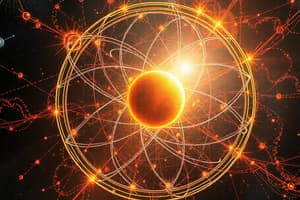Podcast
Questions and Answers
What did John Dalton propose about the structure of atoms in 1803?
What did John Dalton propose about the structure of atoms in 1803?
- Atoms contain a nucleus at the center surrounded by electrons.
- Atoms are composed of negative particles called electrons.
- Atoms are indivisible and cannot be broken down further.
- Atoms are spherical particles similar to snooker balls. (correct)
Which scientist is associated with the discovery of neutrons in 1932?
Which scientist is associated with the discovery of neutrons in 1932?
- James Chadwick (correct)
- John Dalton
- Ernest Rutherford
- JJ Thompson
According to Rutherford’s 1911 experiment, what significant finding was revealed about the atom?
According to Rutherford’s 1911 experiment, what significant finding was revealed about the atom?
- Much of an atom is empty space. (correct)
- Atoms contain a solid core surrounded by electrons.
- Atoms are completely filled with matter.
- Atoms have equal amounts of electrons and protons.
What was a key feature of Niels Bohr’s model of the atom proposed in 1913?
What was a key feature of Niels Bohr’s model of the atom proposed in 1913?
What does the nuclear model of the atom today build upon?
What does the nuclear model of the atom today build upon?
Who proposed the 'plum pudding model' in 1904?
Who proposed the 'plum pudding model' in 1904?
Rutherford's gold foil experiment demonstrated that the atom is completely solid with no empty space.
Rutherford's gold foil experiment demonstrated that the atom is completely solid with no empty space.
What did James Chadwick discover in 1932?
What did James Chadwick discover in 1932?
The __________ model of the atom is based on the ideas of Bohr and Chadwick.
The __________ model of the atom is based on the ideas of Bohr and Chadwick.
Match each scientist with their contribution to atomic theory:
Match each scientist with their contribution to atomic theory:
Match the following years with their associated contributions to atomic structure:
Match the following years with their associated contributions to atomic structure:
Match each scientist with their atomic model or theory:
Match each scientist with their atomic model or theory:
Match the following scientists with their key experiments or discoveries:
Match the following scientists with their key experiments or discoveries:
Match the atomic models with their descriptions:
Match the atomic models with their descriptions:
Match the following atomic structure discoveries with their respective scientists:
Match the following atomic structure discoveries with their respective scientists:
Match the following elements of atomic theory with their respective time periods:
Match the following elements of atomic theory with their respective time periods:
Match the contributions to atomic theory with their respective inventors:
Match the contributions to atomic theory with their respective inventors:
Flashcards
Democritus's Atom Theory
Democritus's Atom Theory
Greek philosopher Democritus proposed that all matter is made up of tiny, indivisible particles called atoms. This idea marked the beginning of the concept of atoms.
Dalton's Model
Dalton's Model
John Dalton extended the atom concept in the early 19th century. He proposed that atoms were solid, spherical like tiny balls, similar to snooker balls.
Plum Pudding Model
Plum Pudding Model
J.J. Thomson suggested the 'plum pudding model'. He proposed atoms were like a positively charged sphere (the pudding) with negatively charged electrons embedded within (the plums).
Rutherford's Model
Rutherford's Model
Signup and view all the flashcards
Bohr's Model
Bohr's Model
Signup and view all the flashcards
What is the atomic theory?
What is the atomic theory?
Signup and view all the flashcards
What did Dalton's model of the atom look like?
What did Dalton's model of the atom look like?
Signup and view all the flashcards
What is the 'plum pudding model'?
What is the 'plum pudding model'?
Signup and view all the flashcards
What did Rutherford's gold foil experiment discover?
What did Rutherford's gold foil experiment discover?
Signup and view all the flashcards
What is Bohr's model of the atom?
What is Bohr's model of the atom?
Signup and view all the flashcards
What is the nucleus?
What is the nucleus?
Signup and view all the flashcards
What are electrons?
What are electrons?
Signup and view all the flashcards
What are neutrons?
What are neutrons?
Signup and view all the flashcards
What did Rutherford discover?
What did Rutherford discover?
Signup and view all the flashcards
Who first proposed that matter is made up of atoms?
Who first proposed that matter is made up of atoms?
Signup and view all the flashcards
Study Notes
History of the Atom:
- 400 BC: Greek philosopher Democritus proposed that all matter is composed of indivisible particles called 'Atomos', which is the origin of the word 'atom'. These particles could not be further divided.
- 1803: John Dalton suggested atoms are spherical particles, like snooker balls.
- 1904: JJ Thomson proposed the "plum pudding model," picturing atoms as a sphere of positive charge with negatively charged electrons embedded within.
- 1911: Rutherford's gold foil experiment demonstrated that atoms contain a dense, positively charged nucleus at the center, surrounded by mostly empty space. Most alpha particles passed through the foil, but some were deflected.
- 1913: Bohr proposed that electrons orbit the nucleus in specific energy levels called orbitals. He calculated that specific energy levels and electrons occupied these orbitals.
- 1932: James Chadwick discovered neutrons, neutral particles residing within the nucleus. Neutrons have no charge, but significantly contribute to the atomic mass. This discovery reconciled the difference between the mass of a nucleus and the mass of its protons.
- Current Model: Today's atomic model, the nuclear model, combines Bohr's orbitals and Chadwick's neutrons. Protons (positively charged), neutrons (neutrally charged), and electrons (negatively charged), make up the atom. Electrons occupy specific energy levels/orbitals.
Summarized Version:
- 400 BC: Democritus proposed indivisible particles called atoms.
- 1803: Dalton suggested atoms are spherical.
- 1904: Thomson proposed the plum pudding model.
- 1911: Rutherford's experiment revealed a dense, positive nucleus.
- 1913: Bohr described electron orbitals in specific energy levels.
- 1932: Chadwick discovered neutrons, contributing mass to the atom.
- Current Model: Modern atomic theory combines the findings of Bohr and Chadwick, creating a nuclear model.
Studying That Suits You
Use AI to generate personalized quizzes and flashcards to suit your learning preferences.




